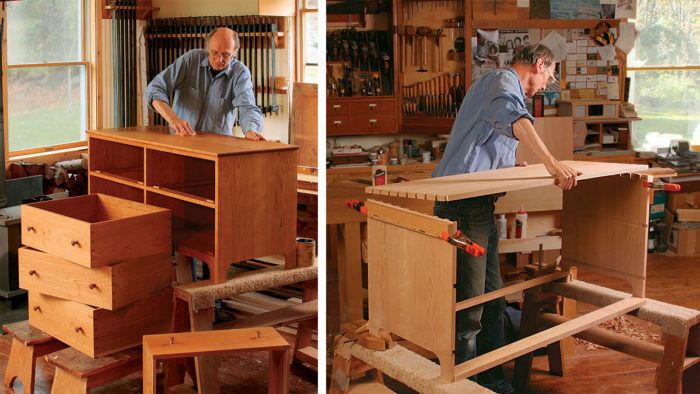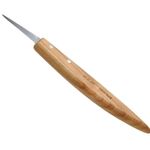Shaker Chest of Drawers
A pro's jigs and tips simplify joinery on chests of any size
Synopsis: This low chest is a twist on the traditional Shaker blanket chest. While its size and appearance are similar to that of a blanket chest and it can fit at the foot of the bed, the drawers make it a more convenient storage place for smaller items like sweaters and clothes. As with much of Becksvoort’s work, this design is heavily influenced by the Shaker design ethic, with its simple lines, functional design, solid construction, and cherry wood. Half-blind dovetails secure the sides to a subtop, and a sliding dovetail secures the bottom to the sides. A vertical divider gets centered in the top and bottom and dadoed in place. Front and back rails are notched around the vertical divider and dovetailed into place. A sturdy frame-and-panel back ensures that the piece looks beautiful from all directions.

Years ago, clients wanted me to make a blanket chest to store shirts and sweaters. Blanket chests are great for quilts and blankets, but they tend to allow small items to drift toward the bottom and get lost. For clothes, I mused, drawers would make the contents more accessible. And if I used the same outside dimensions as a blanket box, they could still place the chest at the foot of the bed and sit on it, or push it against the wall to use as a dresser. The different drawer depths would add to the versatility of what the chest could hold. They took my advice and they still love the finished chest.
As with much of my work, this design is heavily influenced by the Shaker design ethic, with its simple lines, functional design, solid construction, and cherry wood. There are a number of parts, but the construction is straightforward. I use half-blind dovetails to secure the sides to a subtop, and a sliding dovetail to secure the bottom to the sides. A vertical divider gets centered in the top and bottom and dadoed in place. Front and back rails are notched around the vertical divider and dovetailed into place. I use a sturdy frame-and-panel back, glued into a rabbet, so the piece looks beautiful from all directions. And the main top gets screwed in place from the underside of the subtop. This is the same construction I use on all my case pieces, so the anatomy could work for a taller chest, too.
Tackle the sides first
Most of the business happens on the side pieces. But before I hand-chop any half-blind dovetails, the side pieces get a rabbet, leg arches, a sliding dovetail, and a dado with a dovetail at the front.
First, rabbet the side pieces with two ripcuts on the tablesaw. This rabbet will accept the back. Then, draw the leg arches on the side pieces and use a bandsaw to cut them out and a block plane to smooth the straight edges. I clean up the arches using a balloon sander on my lathe and finish up with hand sanding.
Now it’s time to pick up the router and tackle the dado/dovetail that holds the front and back rails and the drawer runners, as well as the sliding dovetail that holds the bottom. For all three I use a shopmade jig with two parallel bars, spaced the width of the router base, clamping it square to the carcase side. The same jig works for the dadoes on the sides of the vertical divider and the dadoes in the subtop and bottom that hold the vertical divider. While the router and jig are out, cut the dadoes in each side of the vertical divider.
Get Becksvoort’s finish recipe for this chest of drawers in an online extra.
From Fine Woodworking #206
For the full article, download the PDF below:
Fine Woodworking Recommended Products

Pfiel Chip Carving Knife

Bessey EKH Trigger Clamps

Freud Super Dado Saw Blade Set 8" x 5/8" Bore

Get the Plan
Digital plans, a cutlist, and a SketchUp drawing for this project are available in the Fine Woodworking store.























Log in or create an account to post a comment.
Sign up Log in